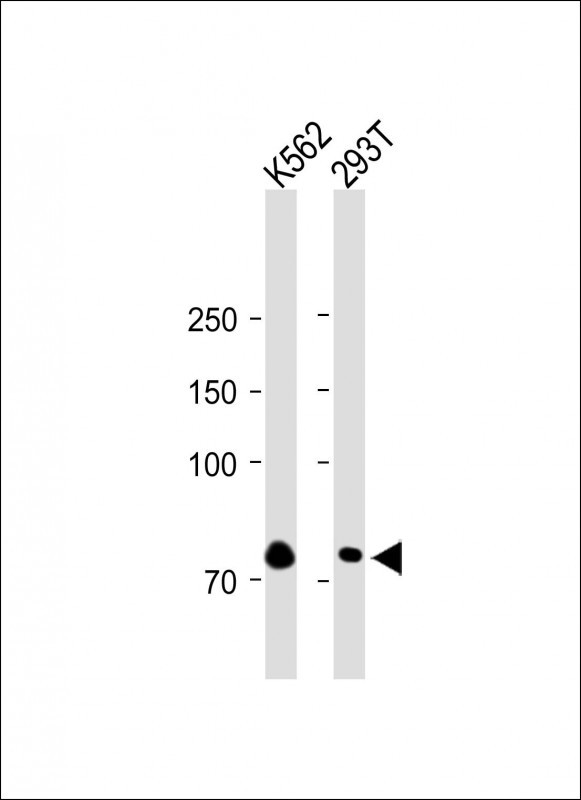
| WB | 咨询技术 | Human,Mouse,Rat |
| IF | 咨询技术 | Human,Mouse,Rat |
| IHC | 咨询技术 | Human,Mouse,Rat |
| ICC | 技术咨询 | Human,Mouse,Rat |
| FCM | 咨询技术 | Human,Mouse,Rat |
| Elisa | 咨询技术 | Human,Mouse,Rat |
| Aliases | Nucleolar GTP-binding protein 1, Chronic renal failure gene protein, GTP-binding protein NGB, GTPBP4, CRFG, NOG1 |
| Entrez GeneID | 23560 |
| WB Predicted band size | 74.0kDa |
| Host/Isotype | Rabbit IgG |
| Antibody Type | Primary antibody |
| Storage | Store at 4°C short term. Aliquot and store at -20°C long term. Avoid freeze/thaw cycles. |
| Species Reactivity | Human, Mouse, Rat |
| Immunogen | This GTPBP4 antibody is generated from a rabbit immunized with a KLH conjugated synthetic peptide between 477-510 amino acids from human GTPBP4. |
+ +
以下是关于GTPBP4抗体的3篇参考文献(文献名称、作者及摘要概括):
1. **"GTPBP4 promotes tumor progression in colorectal cancer via stabilizing β-catenin"**
- **作者**: Liu et al., 2021
- **摘要**: 研究通过免疫组化(使用GTPBP4抗体)发现GTPBP4在结直肠癌中高表达,并通过稳定β-catenin蛋白促进肿瘤生长和转移。
2. **"GTPBP4 interacts with p53 to regulate ribosomal RNA synthesis"**
- **作者**: Zhang et al., 2019
- **摘要**: 利用GTPBP4抗体进行免疫共沉淀实验,揭示GTPBP4与p53结合调控核糖体RNA合成,影响细胞增殖及DNA损伤应答。
3. **"GTPBP4 as a prognostic biomarker in hepatocellular carcinoma"**
- **作者**: Wang et al., 2020
- **摘要**: 通过Western blot和免疫组化(基于GTPBP4抗体)发现GTPBP4在肝癌组织中过表达,其水平与患者生存率负相关,提示其作为预后标志物的潜力。
4. **"GTPBP4 deficiency disrupts ribosomal maturation and causes developmental defects"**
- **作者**: Chen et al., 2018
- **摘要**: 研究利用GTPBP4敲除模型及抗体检测,证明GTPBP4在核糖体成熟中的关键作用,其缺失导致胚胎发育异常及细胞周期停滞。
以上研究均通过GTPBP4抗体验证蛋白表达或功能,涵盖肿瘤机制、RNA合成调控及发育生物学领域。
The GTPBP4 antibody is a research tool designed to detect and study the GTP-binding protein 4 (GTPBP4), a conserved eukaryotic enzyme involved in ribosome biogenesis and cellular stress responses. GTPBP4. also known as ERBIF-1. belongs to the GTPase superfamily and plays a critical role in ribosome quality control, particularly during the maturation of the 60S ribosomal subunit. It is implicated in resolving stalled translation processes and maintaining mRNA stability under stress conditions. Structurally, GTPBP4 contains a conserved GTPase domain and a unique N-terminal domain, enabling its interaction with ribosomal components and stress granule-associated proteins.
Antibodies targeting GTPBP4 are typically produced in immunized hosts (e.g., rabbits or mice) using purified recombinant protein fragments or synthetic peptides. These antibodies enable researchers to investigate GTPBP4's expression, localization, and function through techniques like Western blotting, immunoprecipitation, immunofluorescence (IF), and enzyme-linked immunosorbent assays (ELISA). They are widely used in studies exploring ribosome assembly defects, neurodegenerative diseases, and cancer, where dysregulation of GTPBP4 has been linked to pathological conditions. Validation of specificity via knockout controls or siRNA silencing is essential, as cross-reactivity with related GTPases may occur. Such antibodies contribute to understanding translational regulation and cellular stress adaptation mechanisms.
×